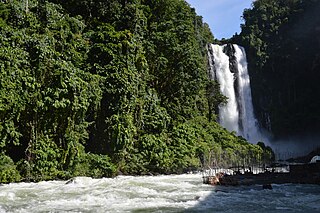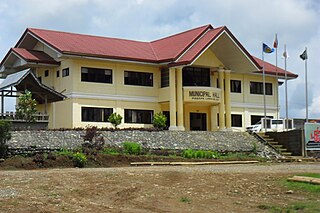
Lanao del Norte, officially the Province of Lanao del Norte, is a province in the Philippines located in the Northern Mindanao region. Its capital is Tubod.

Lanao del Sur, officially the Province of Lanao del Sur, is a province in the Philippines located in the Bangsamoro Autonomous Region in Muslim Mindanao (BARMM). The capital is the city of Marawi, and it borders Lanao del Norte to the north, Bukidnon to the east, and Maguindanao del Norte and Cotabato to the south. To the southwest lies Illana Bay, an arm of the Moro Gulf.

Tugaya, officially the Municipality of Tugaya, is a 5th class municipality in the province of Lanao del Sur, Philippines. According to the 2020 census, it has a population of 24,778 people.

Balindong, officially the Municipality of Balindong, is a 4th class municipality in the province of Lanao del Sur, Philippines. According to the 2020 census, it has a population of 32,573 people.

Bayang, officially the Municipality of Bayang, is a 5th class municipality in the province of Lanao del Sur, Philippines. According to the 2020 census, it has a population of 28,023 people.

Amai Manabilang, officially the Municipality of Amai Manabilang, is a 3rd class municipality in the province of Lanao del Sur, Philippines. According to the 2020 census, it has a population of 12,124 people.

Butig, officially the Municipality of Butig, is a 6th class municipality in the province of Lanao del Sur, Philippines. According to the 2020 census, it has a population of 22,768 people.

Ditsaan-Ramain, officially the Municipality of Ditsaan-Ramain, is a 3rd class municipality in the province of Lanao del Sur, Philippines. According to the 2020 census, it has a population of 24,406 people.

Piagapo, officially the Municipality of Piagapo, is a 4th class municipality in the province of Lanao del Sur, Philippines. According to the 2020 census, it has a population of 30,132 people.

Poona Bayabao, officially the Municipality of Poona Bayabao, is a 4th class municipality in the province of Lanao del Sur, Philippines. According to the 2020 census, it has a population of 31,141 people.

Saguiaran, officially the Municipality of Saguiaran, is a 4th class municipality in the province of Lanao del Sur, Philippines. According to the 2020 census, it has a population of 26,712 people.

Tamparan, officially the Municipality of Tamparan, is a 5th class municipality in the province of Lanao del Sur, Philippines. According to the 2020 census, it has a population of 32,074 people.

Bacolod, officially the Municipality of Bacolod, is a 4th class municipality in the province of Lanao del Norte, Philippines. According to the 2020 census, it has a population of 24,367 people. The town is home to an old Spanish fort, known as Fuerza de Bacolod, which is in dire need of proper conservation and faithful restoration by the National Museum of the Philippines.

Kauswagan, officially the Municipality of Kauswagan, is a 5th class municipality in the province of Lanao del Norte, Philippines. According to the 2020 census, it has a population of 24,193 people.

Kolambugan, officially the Municipality of Kolambugan, is a 4th class municipality in the province of Lanao del Norte, Philippines. According to the 2020 census, it has a population of 28,265 people.

Linamon, officially the Municipality of Linamon, is a 5th class municipality in the province of Lanao del Norte, Philippines. According to the 2020 census, it has a population of 21,269 people.

Magsaysay, officially the Municipality of Magsaysay, is a 5th class municipality in the province of Lanao del Norte, Philippines. According to the 2020 census, it has a population of 20,463 people.

Maigo, officially the Municipality of Maigo, is a 4th class municipality in the province of Lanao del Norte, Philippines. According to the 2020 census, it has a population of 23,337 people.

Munai, officially the Municipality of Munai, is a 4th class municipality in the province of Lanao del Norte, Philippines. According to the 2020 census, it has a population of 35,020 people.

Sultan Naga Dimaporo, officially the Municipality of Sultan Naga Dimaporo, is a 5th class municipality in the province of Lanao del Norte, Philippines. According to the 2020 census, it has a population of 60,904 people. It was formerly known as Karomatan.
























